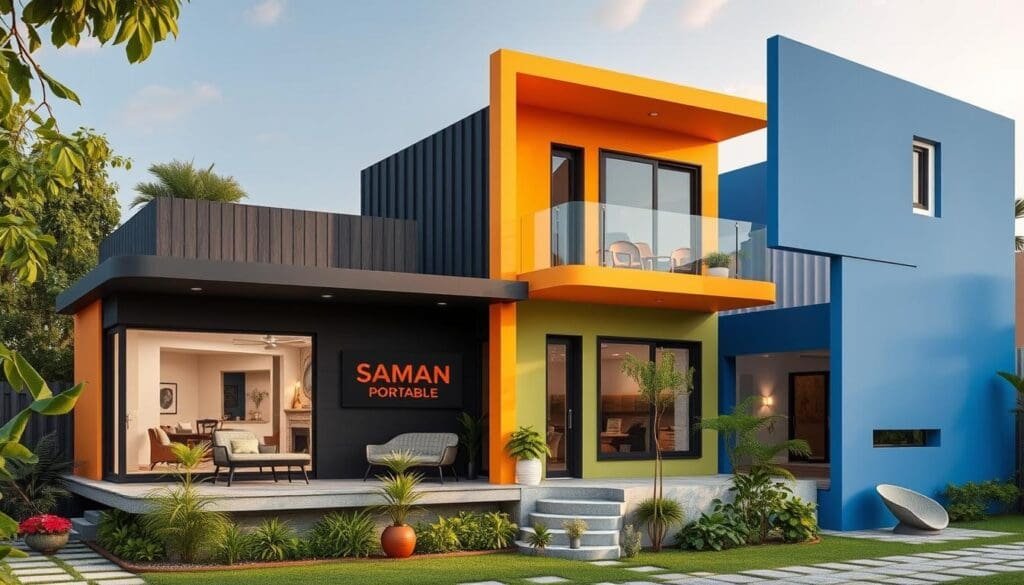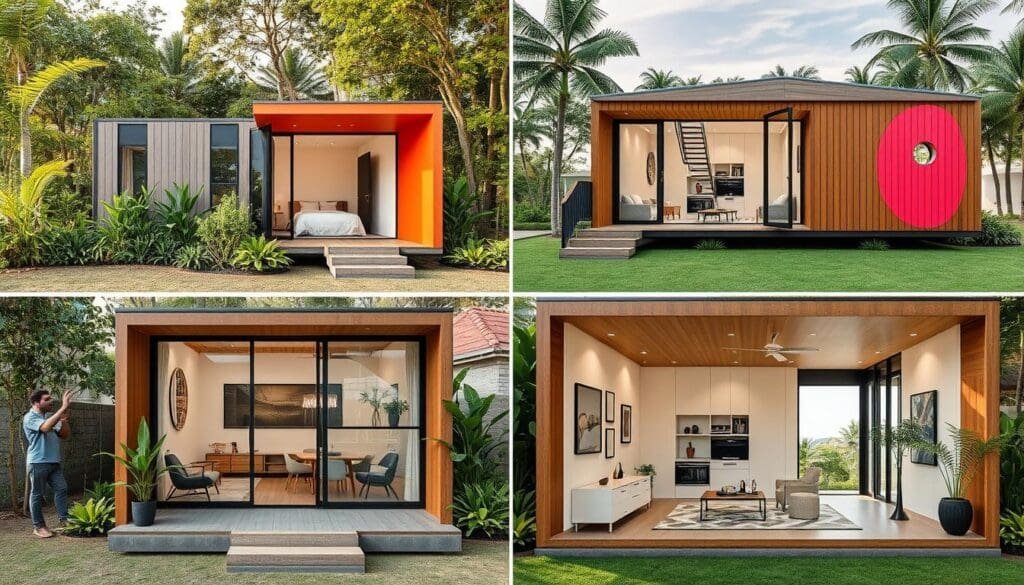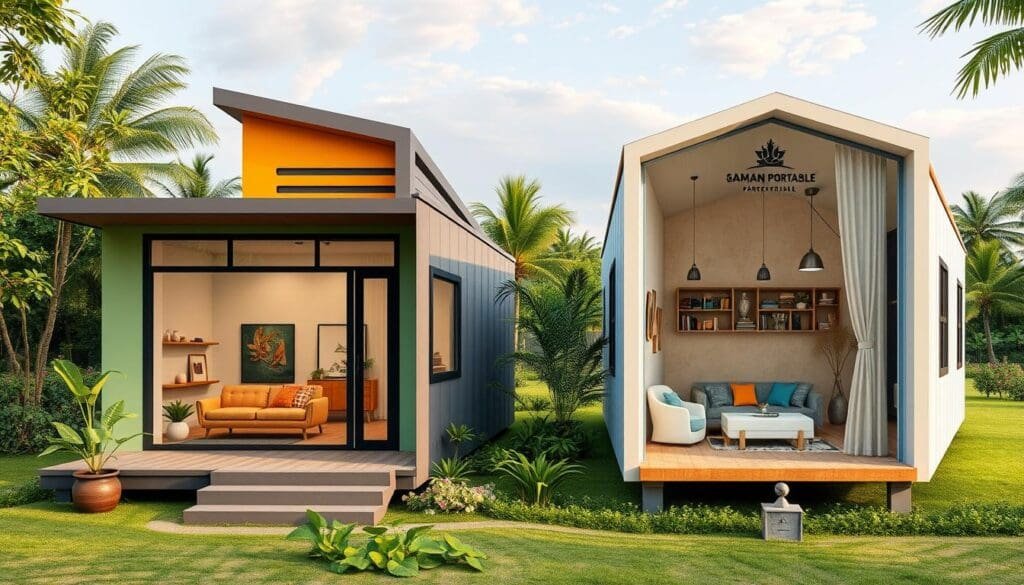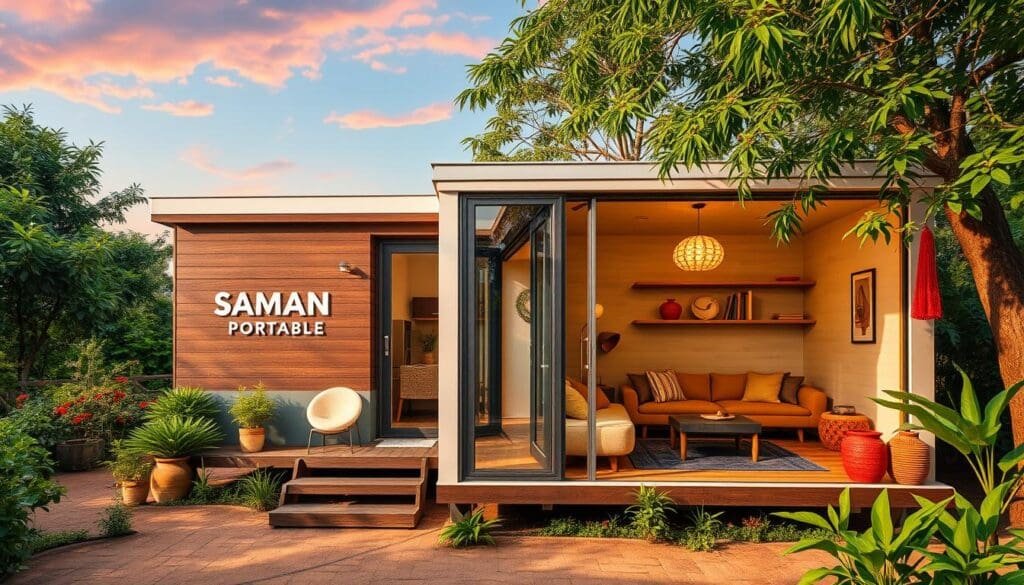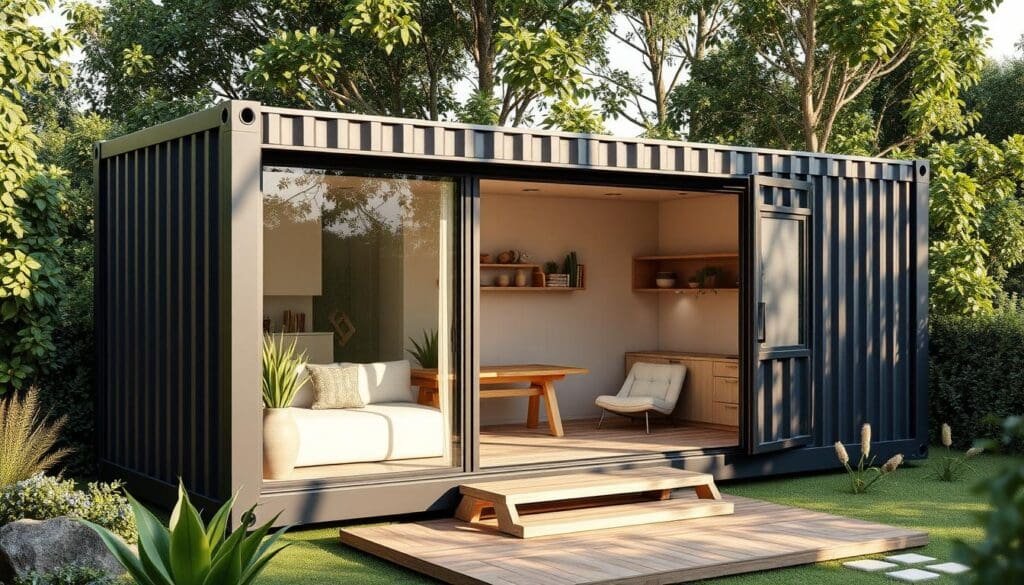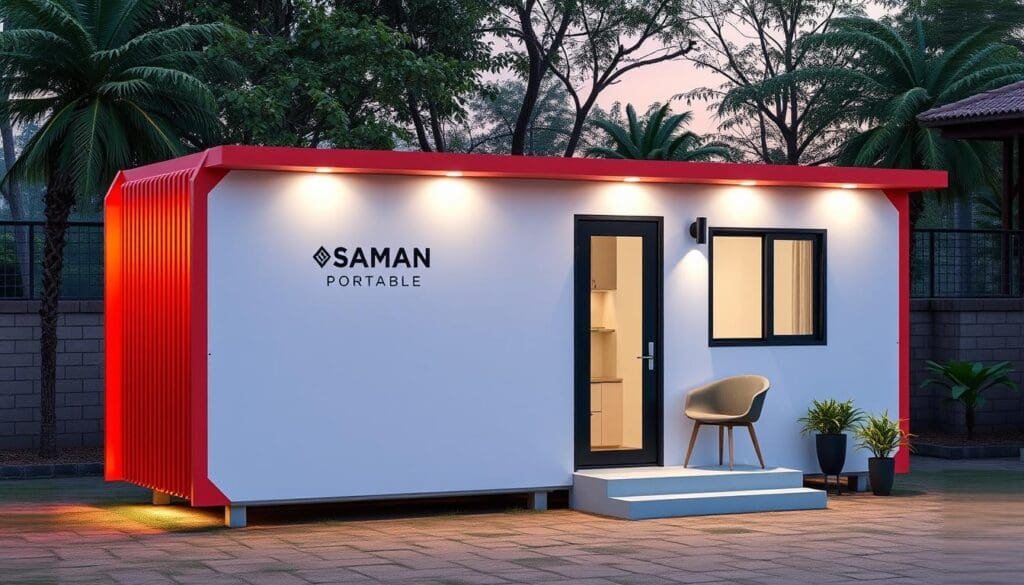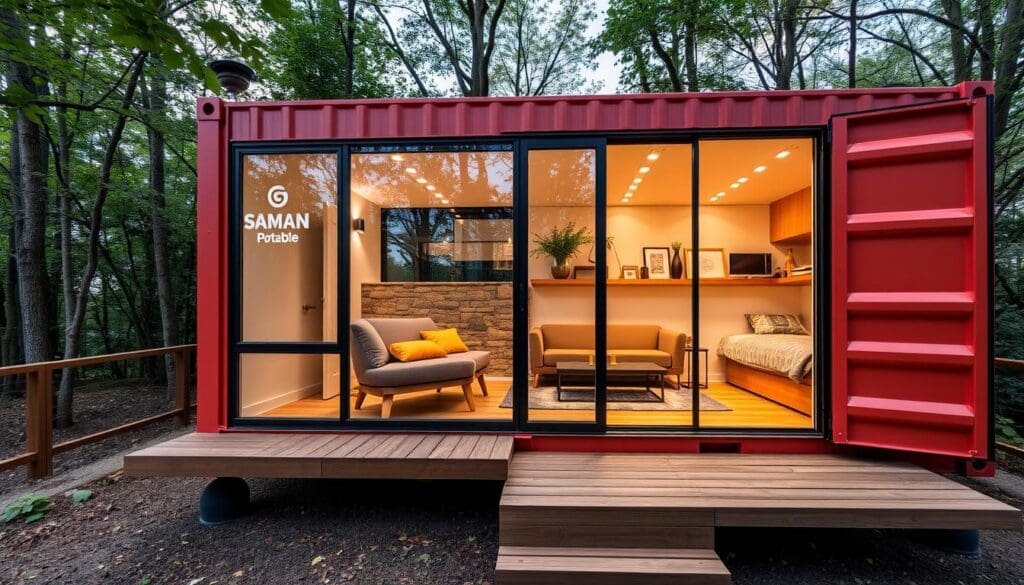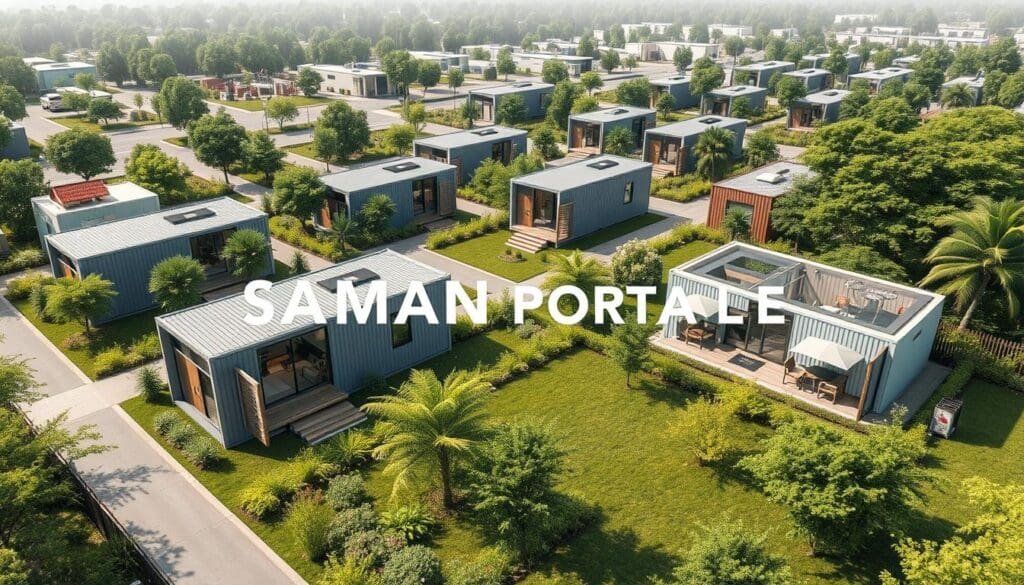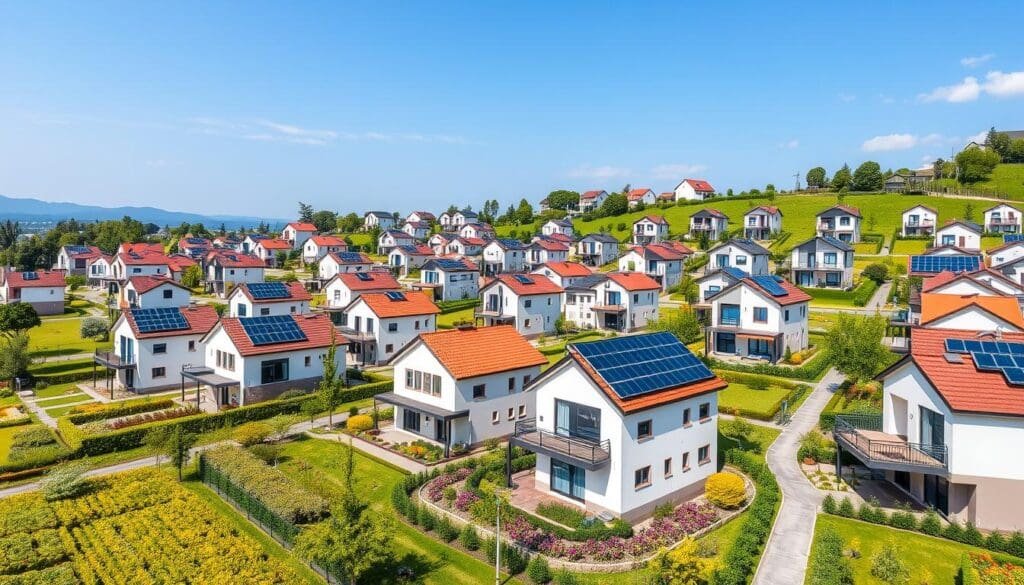Top Prefabricated House for Sale: Affordable, Stylish, and Sustainable Living Options
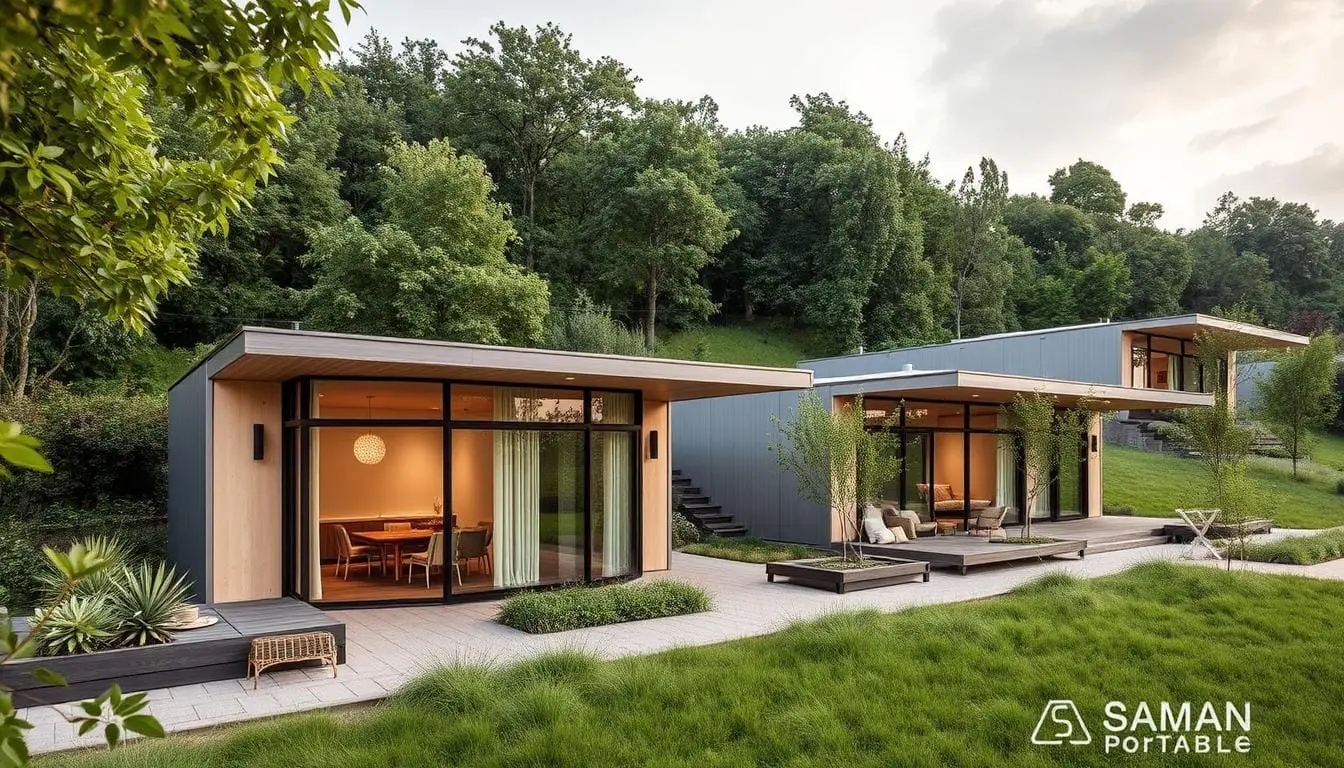
In today’s fast world, many are looking at prefabricated houses as a smart choice. But are these homes really worth it? What makes the best prefabricated houses stand out, and how can they improve your life?
SAMAN Portable is leading the way in a prefabricated house for sale and cottage. They’ve completed over 400 projects, covering 250,000+ square feet in 50+ cities in India. SAMAN Prefab in Delhi is known for its custom prefab homes that are both stylish and durable.
Prefabricated houses are an innovative solution for modern living. Looking for a wide range of options? Visit our detailed guide here: Prefabricated Homes for Sale.
Key Takeaways
- SAMAN Prefab specializes in designing and manufacturing high-quality prefab homes and cottages with a 50+ year economic lifespan.
- Their prefab homes come with a 20-year warranty on structure and leakage, ensuring long-term peace of mind.
- SAMAN Prefab’s prefab homes are equipped with outstanding insulation for year-round thermal comfort, promoting energy efficiency.
- These prefab homes are designed with contemporary, innovative prefab cabin designs and sustainable features, making them a stylish and eco-friendly living option.
- SAMAN Prefab has a proven track record of delivering over 400 prefab homes and cottages, showcasing their expertise and reliability.
Understanding Modern Prefabricated Housing Solutions
The construction world is changing fast. Prefabricated and modular homes are now key players. They’re not just affordable but also stylish and green. These homes have changed how we build and think about living spaces.
Evolution of Prefab Architecture
Prefab homes have a long history, starting in the 19th century. Over time, they’ve improved a lot. Now, they’re built to be safe, energy-efficient, and top-quality.
Benefits of Factory-Built Homes
- Cost-effective construction: Prefab homes save up to 30% per square foot compared to traditional homes.
- Faster construction timeline: Building in a factory speeds up the process, saving time on-site.
- Design flexibility: Modular homes let you customize everything, from layout to finishes.
- Improved energy efficiency: They use advanced insulation and materials, saving on bills and being kinder to the planet.
Quality Control Standards
Prefab and modular homes meet the same building codes as regular homes. They’re made in top-notch factories. This ensures they’re built to last and safe to live in.
| Feature | Benefit |
|---|---|
| Modular Construction | Faster construction timeline and increased design flexibility |
| Energy-Efficient Design | Lower utility costs and reduced environmental impact |
| Customization Options | Tailored living spaces that cater to individual preferences |
| Quality Control | Consistent high-quality and adherence to safety standards |

The prefab world has led to new, customizable portable cabin designs and luxury porta cabin options. These homes, like a portable cabin with bathroom, mix function, beauty, and green living. As the prefab world grows, it’s changing how we live today.
Time and Cost Efficiency in Prefab Construction
Prefab construction is changing the building world by saving time and money. Most of the work is done in a factory, cutting down on weather delays. This means projects can finish up to 50% faster than usual.
Site and foundation work can happen at the same time, making prefab even more cost-effective. This approach helps keep costs down and speeds up the process.
The National Association of Home Builders (NAHB) says prefab homes have lower permit costs. This is because about 80% of prefab homes are built for the people who will live in them. This saves a lot of money for both homeowners and developers.
| Prefab Construction Advantages | Traditional Construction Disadvantages |
|---|---|
|
|
Prefab construction is becoming more popular in India. It offers big advantages like saving time and money. This makes it a great choice for building modular portable cabins or shipping container offices.

Sustainable Features of Modern Prefab Homes
Prefabricated houses are very sustainable. They make less waste and disturb the site less. SAMAN Portable, a top provider of affordable container offices, focuses on being eco-friendly.
Eco-Friendly Building Materials
SAMAN Portable uses green materials like structural insulated panels (SIPs). These materials help make homes that use no energy and produce no carbon. This means less CO2 emissions and better energy use.
Energy-Efficient Design Elements
SAMAN Portable’s homes are designed to save energy. They have good insulation, smart window placement, and use renewable energy. These features help reduce environmental impact and keep homes comfortable all year.
Waste Reduction Practices
- SAMAN Portable cuts down construction waste by up to 90%. This is because materials are measured and cut in a factory.
- Their homes last 50+ years and can be recycled. This means they have a low environmental impact.
- The modular parts of SAMAN Portable’s homes are seen as ‘temporary’. This adds to their green credentials.
SAMAN Portable is at the forefront of sustainable prefab homes. They offer stylish, functional, and eco-friendly options. This makes them a leader in the market.

Prefabricated House for Sale: Current Market Options
The world of prefabricated housing is changing fast. Now, there are many affordable and innovative homes for buyers. Companies like top manufacturers and suppliers including SAMAN Portable in Bangalore and SAMAN Prefab in Noida or Delhi, are leading the way. They offer a wide range of homes to fit different lifestyles and budgets.
Saman Portable offers modern, modular homes at various prices, starting at ₹1,400 per square foot. Saman Prefab in Noida provides customizable homes ranging from 958 to 1,288 square feet, starting at approximately ₹13.4 lakh. Saman Portable’s affordable modular series offers solutions starting at ₹14 lakh, excluding site work. Their eco-friendly homes are competitively priced, making them a great option for sustainable living.
In India, the prefabricated housing market is also lively. There are many options for different budgets and needs. Panel Build Prefabricated Steel Houses cost ₹1,500 per square foot. Steel Modular Prefabricated Houses are priced at ₹1,250 per square foot. Fabricated Farm Houses are available at ₹500 per square foot and have a high response rate of 88%.
| Product | Price (per sq ft) | Capacity/Features |
|---|---|---|
| Panel Build Prefabricated Steel Houses | ₹1,500 | – |
| Mild Steel 40 feet Used Shipping Containers | ₹2,90,000 per piece | 10-20 tons |
| Steel Modular Prefabricated Houses | ₹1,250 | – |
| Fabricated Farm House | ₹500 | 88% response rate |
| Steel Prefab Modular Home | ₹1,000 | – |
| Steel Modular Prefabricated Panel Cottages | ₹1,600 | – |
| Prefabricated Farmhouse PANEL | ₹2,200 | Weatherproof |
With so many prefabricated options like prebuilt container homes available, buyers can find affordable, stylish, and sustainable options. This makes modern, eco-friendly living a real possibility.

Customization Options and Design Flexibility
In the world of prefabricated houses, customization and design flexibility are key. Companies like SAMAN Portable Office Solutions offers a wide range of customizable portable cabin designs. They cater to the unique needs and preferences of their clients. With over 12 years of experience and more than 200 structures, SAMAN Portable is a trusted and innovative player in prefab construction.
SAMAN Portable’s luxury porta cabin solutions let homeowners personalize their homes. They can choose the interior layout, exterior finishes, and smart home integration features. Clients can work closely with the design team to bring their vision to life. The company’s proprietary technology, SAMANIQ, enables seamless integration of smart home features. This empowers residents to control and monitor their living environment with ease.
Interior Layout Choices
- Open-concept living spaces
- Customizable room configurations
- Flexible furniture arrangements
- Specialized areas (e.g., home office, gym, media room)
Exterior Finishing Options
- Various siding materials (wood, metal, composite)
- Diverse color palettes and finishes
- Architectural details (e.g., roof styles, window treatments)
- Integrated outdoor living spaces (decks, patios)
Smart Home Integration
Saman Portable’s SAMANIQ platform integrates a wide range of smart home technologies. This includes energy-efficient appliances, automated lighting and climate control, and advanced security systems. This cutting-edge system lets homeowners manage their living environment with a few taps on their smartphone or voice commands. It enhances convenience, comfort, and energy efficiency.

Weather Resistance and Durability Features
At SAMAN Portable, we’re the top porta cabins supplier in the area. We create modular portable cabin solutions that last. Our designs and engineering ensure our cottages and homes can handle many weather conditions.
These include heavy sun, winds up to 180 Kmph, heavy rainfall, and snow loads up to 2 feet.
Our products’ durability comes from high-quality materials and construction. The outside of our structures is covered with weatherproof membranes. This creates a strong barrier against the elements and ensures they last long.
Our prefab homes also have reinforced frames. These frames can handle the challenges of transportation and delivery. This makes our homes more durable than traditional buildings.
With the right care, our SAMAN Prefab cottages and homes can last 50+ years. Our clients know their investment in a best porta cabins supplier will give them a reliable, long-lasting home. No matter the weather, their home will stand strong.

Modular vs Traditional Construction Methods
Choosing between modular and traditional building methods is key for modern homes. Prefabricated homes save time and money, and ensure quality.
Construction Timeline Comparison
Modular homes win in the race against time. The NAHB says they can be built in about three months. This is much faster than traditional homes.
This speed means less money spent on loans and temporary housing for buyers.
Quality Assurance Processes
Prefabricated homes are made in a factory, ensuring top quality. Skilled workers build them, leading to better craftsmanship. This is unlike traditional building, where quality can vary.
Cost Analysis
Modular homes are often cheaper to build. They use less material, cost less to labor, and are built faster. But, the price can change based on custom features, moving, and site prep.
| Metric | Modular Construction | Traditional Construction |
|---|---|---|
| Construction Timeline | ~3 months | Longer, subject to weather and other on-site delays |
| Quality Control | Consistent, factory-controlled environment | Variable, dependent on builder and crew |
| Cost Savings | 20-30% on average | Higher due to on-site labor and material waste |
In summary, modular homes are faster, cheaper, and of higher quality than traditional ones. Buyers looking for luxury portable cabins for sale make a smart, eco-friendly choice.

Premium Prefab Solutions for Luxury Living
In the world of prefabricated houses, a growing segment is catering to the luxury market. Companies like SAMAN Portable in Bangalore and SAMAN Prefab in Delhi specialize in crafting high-end, customizable portable cabin designs. These designs offer a stylish and sustainable living experience.
SAMAN Portable’ luxury porta cabin options are often compared to the quality and aesthetics of European wooden cottages. They boast superior durability and contemporary flair. These prefab houses are engineered to withstand the test of time, providing homeowners with a sense of refined elegance and comfort.
SAMAN Prefab, on the other hand, seamlessly blends prefab and modular construction techniques. They deliver striking, modern-day homes. Their personalized design approach allows clients to tailor the interior layout, exterior finishes, and smart home integration to their unique preferences. This ensures a truly customized living experience.
| Feature | SAMAN Portable | SAMAN Prefab |
|---|---|---|
| Construction Approach | Prefab wooden cottages | Prefab and modular integration |
| Design Style | Contemporary European flair | Striking modern lines |
| Customization Options | Limited to exterior finishes | Extensive, including layout and smart home |
| Durability | Exceptional, built to last | High-quality, modern materials |
These premium prefab solutions for luxury living seamlessly combine the benefits of factory-built construction with personalization and quality. Whether you’re seeking a refined wooden retreat or a cutting-edge, contemporary abode, the luxury porta cabin and customizable portable cabin designs offered by these innovators are worth exploring.

Transportation and Installation Process
The journey of a modular portable cabin or portable office for sale doesn’t end at the factory. SAMAN Prefab optimizes the panel dimensions for efficient loading into standard trucks or shipping containers. This makes transportation worldwide seamless. The careful planning ensures a hassle-free delivery, making the on-site assembly process smooth.
Site Preparation Requirements
Before installation starts, the construction site must be prepared. This includes grading the land, laying a concrete slab, or constructing a raised platform. The site preparation is key for a successful modular home or office installation.
Assembly Timeline
- The assembly process for modular portable cabins and portable offices is simple, quick, and easy to follow.
- Panels are carefully lifted by a light crane truck and placed precisely on the site.
- Sturdy screws secure the panels, forming the structure’s frame.
- Vapor barriers are then installed to seal the building, protecting it from water and moisture.
- The entire process, from factory construction to on-site assembly, is faster than traditional building methods. Some projects are completed in as little as three months.
This streamlined approach to transportation and installation makes modular solutions stand out. They offer a time-efficient and hassle-free experience for both homeowners and commercial clients looking for portable offices or modular cabins.

Financing Options for Prefab Houses
Buying prefabricated homes for sale offers many financing choices. These options are made for prefab homes and the need for affordable container office options.
Many prefab home makers offer in-house financing. They work with banks to give buyers easy financing packages. This makes buying a prefab home simpler and uses the maker’s prefab knowledge.
Traditional mortgages are also available for prefab homes. But, prefab homes might have lower permit values. This can change the loan terms. Buyers should look into local financing options and talk to makers about possible partnerships.
- Chattel Loans: Made for prefab and mobile homes, these loans focus on the structure itself rather than the land.
- Traditional Loans: Need a 20% down payment, treat prefab homes like real estate.
- FHA Loans: Offered by the Federal Housing Administration, these loans have lower down payments for prefab buyers.
- VA Loans: For military service members and veterans, these loans have good terms and lower down payments.
Choosing the right financing is key for prefab home buyers. They should research well, understand the terms, and talk to real estate experts. This ensures a smooth and informed decision.
| Financing Option | Key Characteristics | Typical Down Payment |
|---|---|---|
| Chattel Loans | Loan focused on the prefab structure, not the land | 10-20% |
| Traditional Mortgages | Treat prefab homes as real estate, similar to site-built properties | 20% minimum |
| FHA Loans | Accessible financing options with lower down payment requirements | 3.5-10% |
| VA Loans | Favorable terms and lower down payments for military service members and veterans | 0-10% |
Maintenance and Longevity Considerations
When looking at portable cabin houses or the best porta cabins supplier, how long they last is key. These prefabricated structures can last 50 years or more. This is because of the quality materials and regular upkeep.
The materials used make a big difference. Thicker, stronger parts help a portable cabin house last longer.
Regular Upkeep Guidelines
Keeping a porta cabins supplier product in good shape is crucial. Regular checks and maintenance can stop small problems from getting bigger. This ensures the product works well for a long time.
Modular homes in areas with tough weather need extra care. This helps them stand up to harsh conditions.
Warranty Coverage Details
SAMAN Portable, a top portable cabin house maker, offers a 20-year warranty. This covers structure and leakage from rain. With the right care, their homes and cottages can last over 50 years.
The company stresses the need to follow maintenance tips. This helps keep the homes in great shape and protects the investment of their customers.
| Material Quality | Maintenance | Durability | Eco-Friendliness |
|---|---|---|---|
| Thicker and stronger materials used in permanent modular buildings contribute to their longevity. | Regular inspection and maintenance of major parts are essential for longevity. | Well-maintained modular homes can last for 50 years or more on average. | Prefabricated homes are considered a worthwhile investment, especially in Ontario and across Canada. |
Many modular buildings are seen as weak and unreliable. But, the best porta cabins supplier products are built to last. With the right care, these portable cabin house options can offer long-lasting, eco-friendly living spaces.
Technology Integration in Modern Prefabs
The prefabricated housing market is growing fast. Modern prefab houses stand out because of their tech integration. Companies like Dvele lead this trend, adding advanced tech to their designs. This boosts efficiency, comfort, and sustainability.
Dvele’s DveleIQ smart home platform is a great example. It tracks the home’s performance and works with many smart devices. Homeowners can control things like energy use and security from anywhere.
Other prefab makers are also adding tech to their modular portable cabin designs. They include things like air filters, energy monitors, and automated systems. These features make homes more efficient and comfortable. They also meet the need for green and tech-savvy living spaces.
Smart home systems, energy-saving tech, and advanced features are changing prefab houses. Buyers get the benefits of factory-built homes plus modern tech and eco-friendliness.
Regulatory Compliance and Building Codes
Prefabricated and modular homes must follow the same strict building codes as regular houses. Companies like SAMAN Prefab make sure their homes meet local, state, and national rules. This ensures every prefab house is safe and of high quality.
The homes are built in a controlled factory setting. This setting helps keep the quality consistent and follows industry standards. But, buyers need to know that local laws and codes can affect where and how prefab houses are installed. Working with prefab makers and local officials can help meet these rules and make the installation smooth.
Key Building Codes and Regulations
- International Building Code (IBC) – Widely adopted code regulating commercial and residential construction
- International Residential Code (IRC) – Focuses on single-family homes, townhouses, and low-rise apartments
- National Electrical Code (NEC) – Sets standards for electrical wiring and systems installation
- International Energy Conservation Code (IECC) – Establishes energy efficiency requirements for building design
- NFPA Codes – Fire safety standards including NFPA 101, NFPA 70E, and NFPA 13
- ASHRAE Standards – Covering HVAC systems, indoor air quality, and energy efficiency
- Americans with Disabilities Act (ADA) – Mandates accessibility requirements for buildings
Following these building codes and regulations is key. It protects people, reduces risks, and keeps prefab houses valuable over time. Not following these rules can lead to big financial and legal problems for builders.
| Benefit | Impact |
|---|---|
| Enhanced Marketability and Value | Properties built to code enjoy increased buyer appeal and investment value |
| Sustainability and Eco-Friendliness | Building codes drive innovation in sustainable construction materials and methods |
| Community Resilience | Adherence to codes fortifies buildings against natural disasters and emergencies |
By teaming up with skilled manufacturers and understanding local rules, buyers can make sure their prefabricated homes for sale and portable offices for sale meet all needed standards. This makes for a safe, green, and worthwhile investment.
Conclusion
Prefabricated homes are a great choice compared to building from scratch. They are affordable, stylish, and good for the planet. Companies like SAMAN Portable show how prefab houses can be high-quality and tailored to your needs.
These homes are built fast, are kinder to the environment, and come with cool designs. Prefabricated house for sale is a smart pick for today’s homeowners.
The prefab industry is growing fast. It’s helping meet housing needs and promoting sustainable living options. Prefab homes save money, use less energy, and can be made just how you like them.
They’re perfect for those who want a home that’s both beautiful and eco-friendly. Modern container homes are a big step forward in building homes. It’s changing the way we think about houses.
More and more people are seeing the benefits of prefab living. This new way of building homes is set to change the real estate world for the better.
FAQ
What are the key features and advantages of SAMAN Portable’s prefab houses and cottages?
SAMAN Portable is known for its high-quality prefab houses and cottages. These homes last for over 50 years and come with a 20-year warranty. They are also well-insulated for comfort all year round.
These homes are stylish and modern. They are built using sustainable materials, making them good for the environment.
What are the benefits of prefabricated and modular home construction?
Prefab houses are built to last and cost less per square foot. They are faster to build than traditional homes. This makes them more sustainable and efficient.
They are built in a controlled factory setting. This ensures they meet high standards and follow building codes.
How do the costs and timelines of prefab houses compare to traditional construction?
Prefab houses are more affordable and quicker to build. They use less labor and materials, saving money. The NAHB says prefab homes can be finished in just three months.
What are the sustainable features of Saman Portable’s prefab houses?
Saman Portable focuses on eco-friendly homes. They use advanced building methods like structural insulated panels (SIPs). This helps create homes that use little to no energy.
These homes produce less CO2 and are more energy-efficient. This is good for the planet.
What are the customization options and design flexibility offered by Saman Portable?
Saman Portable lets you design your prefab house. You can choose from many options to fit your needs. This includes the layout, finishes, and even smart home features.
How durable and weather-resistant are Saman Portable’s prefab houses?
Saman Portable’s homes can handle tough weather. They can withstand strong winds, heavy rain, and snow. The outside is protected by weatherproof membranes.
This makes them last for many years.
What are the key differences between modular and traditional construction methods?
Modular homes are built faster, often in just three months. They are also more affordable because they use less labor and materials.
They are built in a factory, ensuring quality. This is different from traditional homes built on-site.
What are the financing options available for Saman Portable’s prefab houses?
Financing for prefab houses varies. Some companies offer their own financing or work with banks. It’s important to check what options are available in your area.
Also, talk to the manufacturer about any financing partnerships they might have.
How does Saman Portable ensure the longevity and maintenance of their prefab houses?
Saman Portable offers a 20-year warranty on their homes. With proper care, they can last over 50 years. They provide maintenance tips to keep them in good shape.
What kind of technology integration can be found in Saman Portable’s prefab houses?
Homes from Saman Portable, like those from Dvele, come with advanced tech. Dvele’s DveleIQ system monitors the home’s performance and works with smart appliances. Other companies might offer similar tech options.
How does Saman Portable and other prefab houses providers ensure compliance with building codes and regulations?
Prefab houses must meet the same building codes as traditional homes. Saman Portable ensures their homes follow local and national rules. The factory setting helps maintain quality and standards.
However, buyers should check local laws and codes. These can affect where and how prefab houses are installed.
 Container Cafe
Container Cafe
















































































